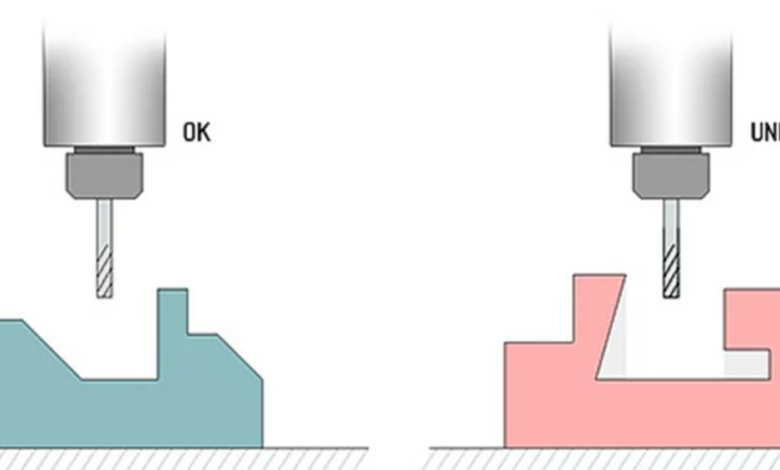
Undercut machining is a critical technique in modern manufacturing that allows engineers and machinists to create complex and intricate features that would otherwise be impossible to achieve using conventional machining methods. This process is essential for industries that require high precision, complex geometries, and tight tolerances. In this article, we will explore the concept of Undercut machining, the methods used to perform it, its applications across various industries, and its benefits in the manufacturing process.
What is Undercut Machining?
Undercut machining refers to the process of creating features on a workpiece where the tool cannot directly reach due to the part’s geometry. An “undercut” typically refers to areas beneath the main surface or around obstacles in the material that prevent a tool from accessing the part from a conventional direction. Essentially, it’s any feature that involves cutting a shape that extends beyond the normal boundaries of the material, requiring the tool to cut from an unconventional angle or position.
In simpler terms, undercuts are areas or features that cannot be accessed with a standard toolpath or standard machining techniques. These features often appear as slots, notches, or recesses on parts where the tool would be blocked by the surrounding material. The ability to produce undercuts is crucial in manufacturing parts with intricate, complex shapes, and it often involves specialized machining tools or advanced manufacturing techniques.
Techniques Used for Undercut Machining
Several machining techniques are employed to create undercuts, depending on the material, part geometry, and desired level of precision. Here are some of the most common methods used in undercut machining:
1. Wire EDM (Electrical Discharge Machining)
Wire EDM is one of the most effective techniques for creating undercuts in electrically conductive materials like metals. This process uses a thin wire as an electrode, which generates electrical discharges to cut through the material. Since the wire can move in multiple directions, it can easily navigate around obstacles and access areas that would be impossible with traditional cutting tools.
Wire EDM is especially useful for producing highly intricate undercuts with tight tolerances and can be used to cut materials that are difficult to machine with traditional methods, such as hardened steel, titanium, and alloys.
2. 5-Axis CNC Machining
5-axis CNC (Computer Numerical Control) machining offers a significant advantage when it comes to creating undercuts. Unlike traditional 3-axis CNC machines, which can only move along the X, Y, and Z axes, 5-axis machines also have the capability to rotate around two additional axes. This allows the cutting tool to approach the workpiece from multiple angles, making it possible to cut undercuts and other complex geometries that are difficult to achieve with standard machining methods.
5-axis machining is especially useful in aerospace, automotive, and medical device manufacturing, where parts often have complex, multi-dimensional features that require undercut machining.
3. Ball-End Milling
Ball-end milling is a technique that uses a ball-shaped cutting tool to mill curves and undercuts in a workpiece. The ball shape allows the cutter to access areas that flat-end mills cannot reach, especially when the undercut involves deep recesses or intricate curves. Ball-end mills are often used in combination with 5-axis CNC machines to create smooth, precise undercuts in a variety of materials, including metals, plastics, and composites.
This method is particularly useful for creating molds, dies, and parts with complex freeform geometries.
4. Laser Cutting
Laser cutting is another technique that can be used to produce undercuts, especially in thin materials such as sheet metal or plastics. The laser’s focused beam of light melts or vaporizes the material, allowing for the creation of intricate shapes, including undercuts. Laser cutting offers high precision and can be automated for high-volume production.
Laser cutting is especially advantageous for producing parts with tight tolerances or fine details, making it an ideal choice for industries like aerospace, automotive, and electronics.
5. Broaching
Broaching is a machining process that uses a toothed tool (broach) to remove material from the surface of a workpiece in a linear direction. It is particularly effective for producing internal undercuts, slots, and other complex shapes. Broaching can be used for both roughing and finishing operations, and the process is capable of producing parts with tight tolerances and high repeatability.
Broaching is commonly used in the production of parts like gears, keyways, and other internal features that require precise undercuts. This method is particularly effective for high-volume production runs.
Applications of Undercut Machining
Undercut machining is used in a variety of industries where precision and complex part geometries are essential. Below are some of the key sectors that benefit from this technique:
1. Aerospace Industry
In aerospace manufacturing, components often require complex, lightweight structures that need to be precise and durable. Undercut machining is crucial for producing turbine blades, engine components, and brackets that have complex internal features or intricate shapes. These parts often need to meet stringent standards for weight, strength, and aerodynamic performance. The ability to machine undercuts helps engineers design components that meet these requirements without sacrificing performance.
2. Automotive Industry
The automotive sector requires a vast array of parts that need to be precisely engineered to ensure vehicle safety, efficiency, and performance. Components like engine blocks, transmission parts, and custom brackets often require undercuts for optimal fitment, improved functionality, or weight reduction. Undercut machining ensures that parts are not only functional but also meet the aesthetic and performance standards set by manufacturers.
3. Medical Device Manufacturing
The medical industry demands high-precision components for devices such as surgical instruments, implants, and prosthetics. Many of these devices have undercut features that are essential for their functionality, such as slots for fixing screws or intricate internal structures for proper fit. Undercut machining enables manufacturers to create these complex shapes with precision, ensuring that medical devices meet safety and performance standards.
4. Mold and Die Making
Undercut machining is a key technique in the production of molds and dies, especially for injection molding processes. When designing molds for plastic parts, undercuts are often necessary to ensure that the final molded part can be easily removed from the mold without damage. Undercut machining allows manufacturers to create complex cavities, ejector systems, and geometric features in the mold, making it easier to produce high-quality plastic components.
5. Tooling and Fixtures
In tooling and fixture manufacturing, undercut machining is used to create custom fixtures that hold workpieces securely during machining operations. These fixtures may have undercut features, such as grooves or channels, to assist in part alignment, secure mounting, or fluid flow. The ability to machine such features allows for greater precision in subsequent machining operations.
Advantages of Undercut Machining
The ability to create undercuts provides several important benefits, particularly when dealing with complex geometries and tight tolerances:
1. Design Flexibility
Undercut machining allows engineers and designers to create more intricate and flexible designs. Without this capability, many components would need to be simplified, leading to potential compromises in performance or function. Undercut machining enables the production of highly optimized parts with minimal material waste and increased functionality.
2. Increased Precision
Undercut machining techniques, such as CNC machining and EDM, are known for their high precision and accuracy. This allows for the creation of parts with tight tolerances and ensures that the final product meets design specifications with minimal deviation.
3. Cost Efficiency
By incorporating undercuts directly into the part design, manufacturers can reduce the need for additional operations such as assembly, welding, or the use of secondary components. This can significantly lower production costs and streamline the manufacturing process.
4. Enhanced Performance
Undercut features can improve the overall performance of a part. For example, undercuts may be used to improve the flow of fluids, reduce stress concentrations, or facilitate the integration of other components, leading to better overall functionality and reliability.
Conclusion
Undercut machining is an essential capability in modern manufacturing, enabling the production of highly complex parts with intricate geometries and tight tolerances. Whether through techniques like wire EDM, 5-axis CNC machining, or laser cutting, undercut machining allows manufacturers to produce components that are essential in industries ranging from aerospace to medical device manufacturing. The ability to create undercuts not only improves design flexibility and part performance but also offers cost-saving opportunities by reducing the need for secondary operations. As manufacturing technology continues to evolve, the importance of undercut machining will only grow, supporting innovation and precision in a wide range of applications.



